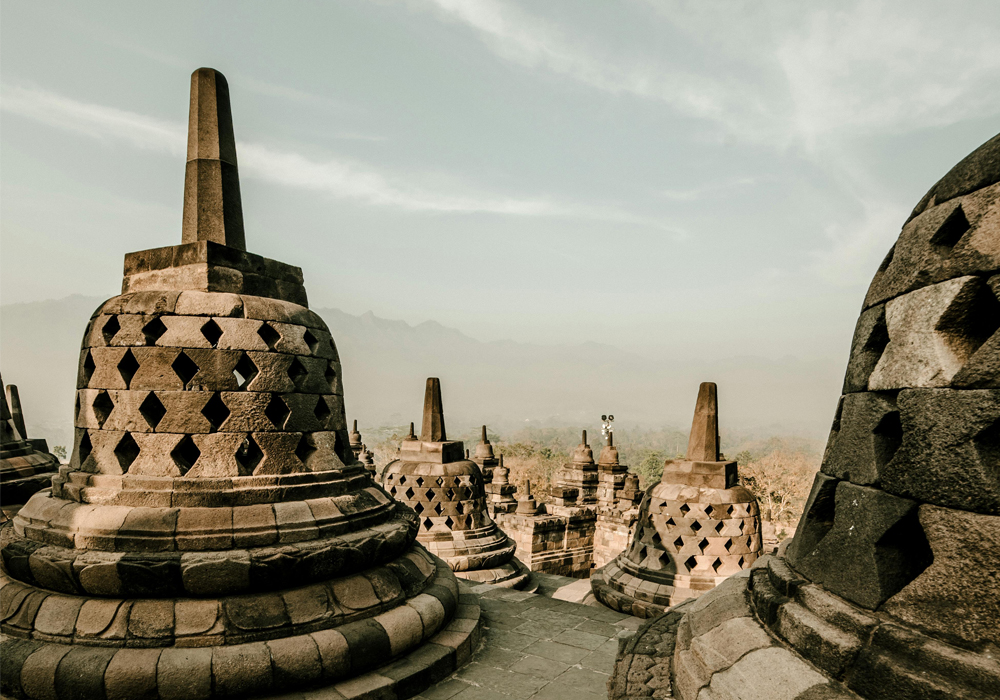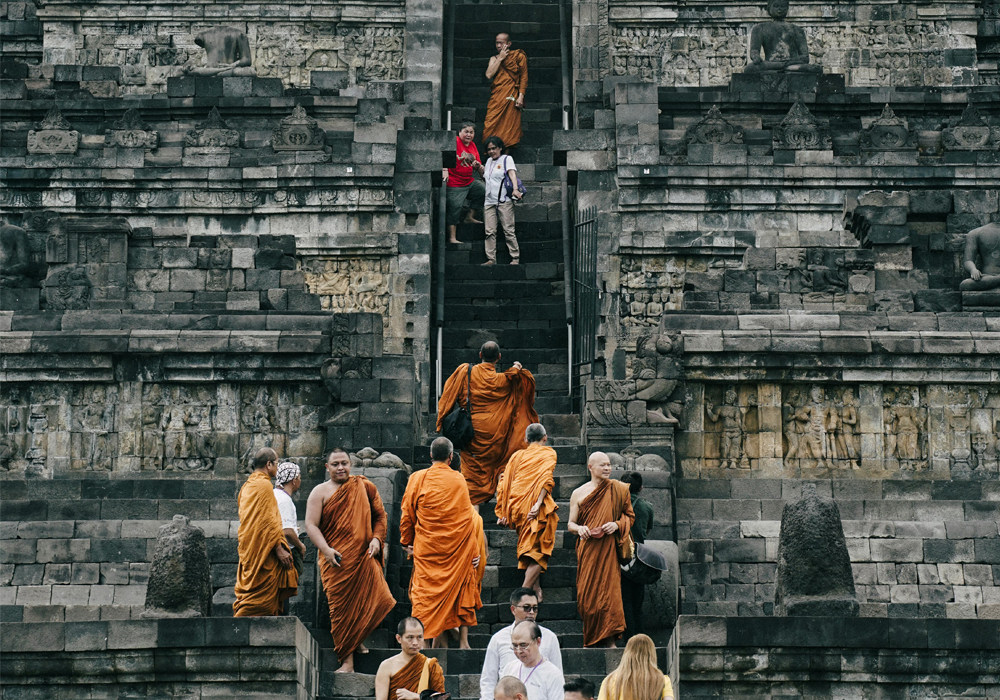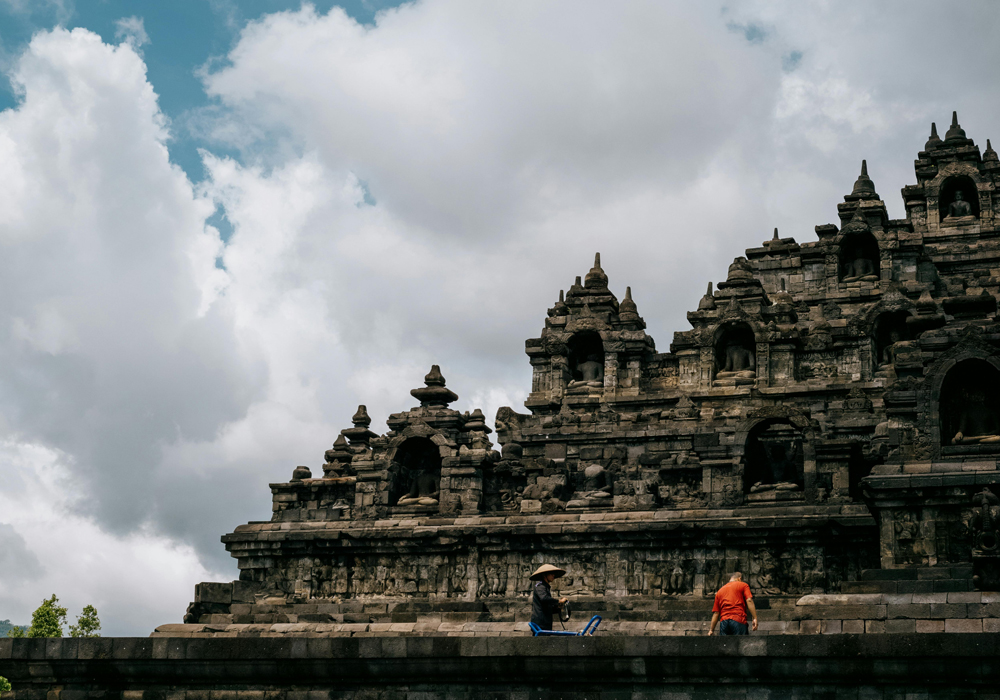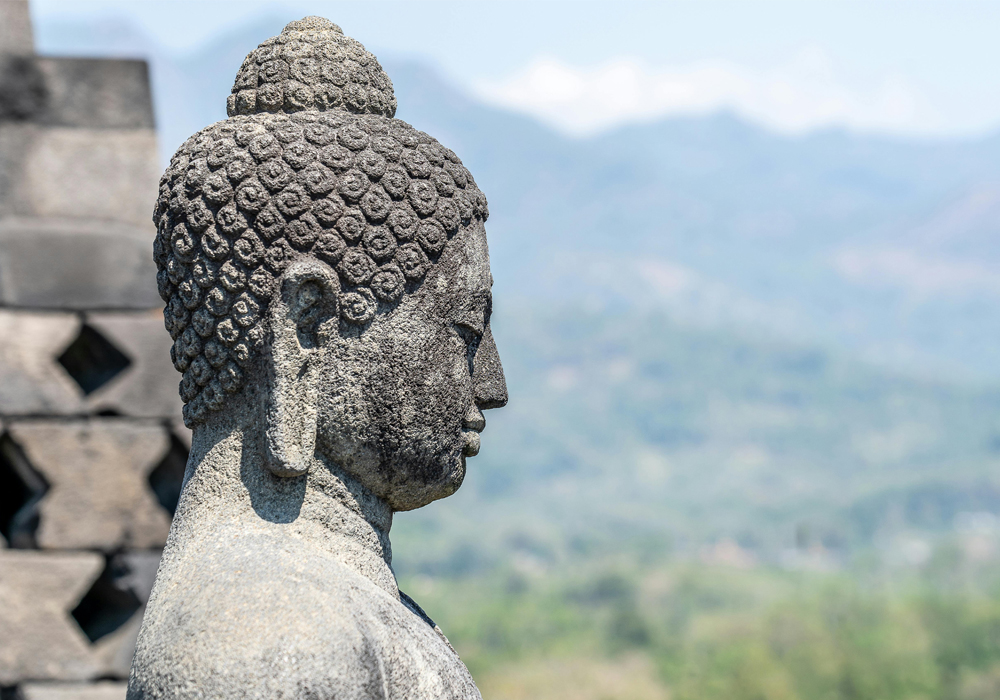Let’s talk about Borobudur, Indonesia’s colossal, ancient, and undeniably spectacular Buddhist monument. Gather ’round, history buffs, spiritual seekers, and anyone who appreciates a massive pile of rocks that somehow stayed put for over a thousand years!
Forget your tiny garden gnome; this is the Big Daddy of all shrines, an architectural flex so enormous it makes modern construction crews weep with envy (and probably shoulder pain).
What on Earth (or in Java) is Borobudur?
So, what is this behemoth? Borobudur is, in short, the world’s single largest Buddhist temple. Now, “temple” might be a bit of an understatement.

Imagine a wedding cake, but instead of frosting and questionable fruitcake, it’s nine stacked stone platforms, carved with enough reliefs to tell the entire life story of the Buddha, and topped with 72 bell-shaped mini-shrines, each containing a grumpy-looking Buddha statue who’s clearly over the whole tourist thing. It’s less a building you go into and more a mountain of spiritual knowledge you walk around and up.
It’s a three-dimensional mandala, a cosmic diagram in stone, essentially giving pilgrims a map to enlightenment, one dizzying step at a time. It’s located in Central Java, just chilling amongst volcanoes and rice paddies, looking magnificent and utterly out of place, like a spaceship landed and decided to become a very, very patient teacher.
The Builders and the Big Question: Why So Huge?
The short, somewhat mysterious answer to “Who built it?” is the Syailendra Dynasty of ancient Java, likely somewhere between the late 8th and early 9th centuries AD. Think of the Syailendras as the rock stars of their day. They didn’t have TikTok, so they communicated their greatness by building things that would last millennia.
And what for? Simple: to honor the Buddha and serve as a grand site for pilgrimage. Pilgrims would start at the base—the realm of earthly desires (the Kāmadhātu)—and ascend, spiraling ever higher, past the realm of forms (Rūpadhātu) with all those narrative reliefs, to the circular, unadorned top—the realm of formlessness (Arupadhātu)—where the central stupa (a reliquary mound) sits, symbolizing nirvana.

It’s literally a physical journey from the messy material world to spiritual transcendence. They didn’t call it an epic trek for nothing.
Now for the real question: Why did it have to be that big? Well, partly because you can’t build a meek little shrine to impress the cosmos.
But mostly, it was a display of immense power, devotion, and a serious amount of volcanic stone. The estimated construction time was around 75 years, which, when you realize they didn’t have cranes, power tools, or even proper mortar (the stones are interlocked like a giant, prehistoric Jenga puzzle), makes you realize the sheer human effort.
It’s built on a natural hill, and they just kept stacking. They probably had a construction foreman named Gunadharma (a name passed down in local tales) who had to be the most persistent person in the whole kingdom.
Imagine him saying, “More rocks! We need to represent the entire cosmos! And make sure there are at least 1,460 relief panels, because we can’t miss a single story of the Buddha’s past lives!” It had to be massive to capture the entire Mahayana Buddhist cosmology and convey the magnitude of the spiritual journey. If enlightenment is a difficult climb, the temple is its giant, stone-cold proof.
The World Heritage Bling and What It Means for Indonesia
Borobudur didn’t get its current fame overnight. After a few centuries, it got abandoned, probably around the time people in Java started converting to Islam, or maybe a nearby volcano threw a massive tantrum (Merapi is known for those).
It was swallowed by volcanic ash and jungle, becoming a genuine “lost city” type of relic, until Sir Thomas Stamford Raffles, the British Lieutenant-Governor of Java (and founder of Singapore, just to show off), heard rumors in 1814 and ordered its clearing.
It’s a hilarious image: Raffles, probably in a starched uniform, directing a couple hundred men to hack away at the jungle to uncover… the world’s largest, stone dome.
Fast forward to 1991, and UNESCO officially designated the Borobudur Temple Compounds as a World Heritage Site. What does that mean? It means Borobudur is officially recognized as having “Outstanding Universal Value”—it’s so important culturally and historically that its preservation is considered the responsibility of the global community. It’s the world saying, “Holy smokes, this rock pile is a brilliant human masterpiece, and we must protect it forever.”
For Indonesia, this status is a monumental source of national pride. It’s a tangible link to a glorious, ancient past where sophisticated art, architecture, and religious thought flourished.
It cements Indonesia’s place on the global cultural map, not just for its stunning natural beauty, but for its deep historical roots and intellectual contributions. It’s like Indonesia wearing a massive, ancient, and deeply spiritual crown, saying, “We’ve been amazing for a very long time.”
The UNESCO listing brought international funding for restoration (which was desperately needed after a millennium of being a jungle gym) and helped establish rigorous conservation rules, ensuring that this gift from the Syailendra Dynasty can be enjoyed by many more generations of bewildered, awe-struck travelers.
Your Epic Quest to Visit Borobudur (and the Rules of Engagement)
So, you want to see this wonder for yourself? Excellent choice! Your base of operations should be Yogyakarta (or Jogja), the closest major city with an airport and all the logistical support you’ll need. From Jogja, Borobudur is about an hour to an hour-and-a-half drive northwest.

You can hire a private car, grab a taxi, or be truly adventurous and try the local bus system (which is cheap but requires a few transfers—definitely the “Nirvana is Hard Work” approach). Many people opt for a pre-dawn start to catch the legendary sunrise over the temple, though keep in mind these “Sunrise Tours” are often run by nearby resorts and come with a premium price tag.
Ticket Time! The entrance fee for foreigners is, shall we say, significantly higher than for local citizens (it’s a common system for world-class sites in many countries to support conservation). As of recent updates, you generally have a few options:
- Temple Ground Ticket (Regular Access): This lets you enter the surrounding park and view the temple from the ground level and lower courtyards. This is the cheaper foreigner option, which currently runs around $25 USD (or about IDR 400,000-415,000 depending on the exchange rate and ticket type).
- Temple Structure Ticket (Climbing Access): This is the one you really want. It allows you to actually climb the monument’s stairs and walk the famous circular path to the top. This costs more (roughly $28-$35 USD, or about IDR 455,000 and up) and is severely limited in capacity—only a set number of people (often 150 per time slot) are allowed up per hour, and it usually includes a mandatory local guide and special sandals (“upanat”) for preservation. You often have to book this in advance, and note that access to the very top platform can be restricted, especially during certain hours or religious ceremonies.
Can and Can’t Do (The Rules for Foreigners): Since Borobudur is a sacred site and a delicate 1,200-year-old treasure, there are rules, and you should treat them with respect—the Buddha is watching!
- CAN:
- Dress Modestly: This is crucial. Cover your shoulders and knees. If you forget, don’t panic—the entrance often provides a sash or sarong to borrow for free, turning you into an instant, stylish pilgrim.
- Wear Comfortable Shoes: You will be climbing. Those stairs are steep, uneven, and numerous. Your fancy sandals will hate you.
- Walk Clockwise (Circumambulation): When you walk the terraces, you’re supposed to follow the path clockwise. It’s part of the spiritual pilgrimage. Also, it prevents traffic jams.
- Hire a Guide: Seriously, the bas-reliefs are a mile long and tell an incredibly complex story. Get a guide; otherwise, it’s just pretty pictures in stone.
- CAN’T:
- Climb or Touch the Reliefs: Don’t be “that” tourist. The stone carvings are incredibly fragile. Look with your eyes, not your hands.
- Sit on the Stupas: Do not treat the bell-shaped stupas as personal benches for your epic selfie. They house Buddha statues and are sacred.
- Eat, Drink, or Smoke on the Temple Structure: This isn’t a picnic. Keep it respectful.
- Fly a Drone without a Permit: You need special permission; otherwise, leave the flying camera at home.
- Visit on a Monday (to Climb): Often, the physical temple structure is closed for climbing on Mondays for maintenance and school trips, though the grounds may still be open. Always check before you go!
In the end, Borobudur is more than just a selfie background. It’s an incredible journey through stone and spirituality, a monument that has survived volcanoes, neglect, and even a small bombing attempt.
It stands as a testament to human devotion and engineering genius, inviting everyone to step away from the noise of the world and just keep climbing. Enjoy the view, enjoy the history, and try not to trip on the path to enlightenment!
